Revision Notes on Human Health and Disease for NEET 2024 - Free PDF Download
Human Health and Diseases is a very important chapter included in the syllabus for NEET. The chapter deals with our human environment and the diseases that humans have. Different diseases and ailments have been explained in the chapter along with their causes and treatment methods. Students can easily grasp the concept of human diseases. In order to develop a further understanding of the chapter, they can download Human Health and Disease Class 12 notes. These revision notes have been created by experts at Vedantu so that students can have an easier explanation of the concept of the chapter.
Downloading these revision notes and simply including them in your study material will enable you to grasp the concepts quicker and thus prepare you for this competitive examination. Have a look at the Human Health and Disease notes right now from Vedantu.
Access NEET Revision Notes Biology Human Health and Disease
Introduction
Health is defined as a state of mental, social and physical being. Disease on the other hand is disturbance in the proper functioning of the body. Which further affects the functioning of organs and organ systems. Thus, both health and disease together contribute to the state of entire well-being. Human health and diseases is an important topic that needs to be studied for a better understanding of our body.
Types of Diseases
The human body suffers from many diseases. Diseases occur due to genetic defects, infections or an unhealthy lifestyle.
Diseases Can be Classified Into Two Types:
Congenital Diseases: The diseases that are present by birth. These are genetic in nature. These may be due to gene mutation, chromosomal aberration or environmental effects. These defects are transferred from one generation to the other. E.g. Hemophilia, color blindness, Down syndrome, Turner’s syndrome, etc.
Acquired Diseases: The diseases that are acquired during a lifetime are known as acquired diseases.
Infectious or Communicable Disease: These are transmitted from one person to another.
Non-communicable Disease: These kinds of diseases do not spread by infection.
Deficiency Disease: Such kinds of diseases are caused due to deficiency of an important nutrient, enzyme or hormones, e.g. anemia, kwashiorkor, beriberi, diabetes, etc.
Allergies: hypersensitivity to foreign substances causes some kinds of allergies.The allergies are caused by pollen, dust, mites, etc.
Common Diseases in Humans
The disease-causing organism is known as a pathogen, e.g. bacteria, virus, protozoan, fungi, worms.
There are many ways by which a pathogen can enter our body. Here is a table of the most common diseases found in humans.
Name of the Disease | Causing Agent/ Pathogen | Vector/ Mode of Infection | Symptoms | Effects |
Typhoid | Salmonella typhi (Bacteria) | By contaminated food and water | Continued high fever, headache, stomachache, constipation and loss of appetite | Can be diagnosed by Widal test. Intestinal perforation in severe cases |
Pneumonia | Streptococcus pneumoniae, Haemophilus influenzae (Bacteria) | By inhaling droplets or aerosols released by an infected person or using infected utensils | Fever, chills, cough and headache | Respiration problems due to fluid that gets filled in the alveoli |
Common cold | Rhinoviruses | By cough, sneezes and contaminated objects | Nasal congestion and discharge, sore throat, cough, headache | Nose and respiratory passage |
Malaria | Plasmodium falciparum, P. vivax (Protozoan) | Female anopheles mosquito is a vector. Spread by mosquito bite | High fever with chills | The parasite multiplies in liver cells, attacks RBCs and rupture |
Amoebic dysentery | Entamoeba histolytica (Protozoan) | Houseflies are a carrier -spread by contaminated food by the faecal matter | Constipation, abdominal pain, mucous and blood in the stool | Infection in the large intestine |
Ascariasis | Ascaris (Helimenthes) | Contaminated water, vegetables, fruits. Parasite eggs are excreted our in faeces of the infected person, which contaminates soil | Muscular pain, internal bleeding, anaemia, fever | Blockage of intestinal passage |
Filariasis/ Elephantiasis | Wuchereria bancrofti, W. malayi (Helminthes) | Bloodsucking black flies and female mosquitos act as a vector | Inflammation of the lower limb and genital organs | Lymphatic vessels, especially of the lower limbs, get blocked |
Ringworms | Microsporum, Trichophyton, Epidermophyton (Fungi) | Spread from the soil, using a towel, clothes or comb of an infected person | Dry scaly lesions, itchy skin | Effects skin, nail scalp |
The Lifecycle of Plasmodium (Malarial Parasite)
Plasmodium enters in the body by the bite of female Anopheles mosquitoes.
The infectious form is sporozoites, which come from the saliva of female anopheles when they bite.
It further multiplies in the liver cells and then attacks RBCs resulting in RBCs rupture.
A toxic substance known as Hemozoin is released.
The gametocyte from the human blood gets transferred to the mosquito when it bites an infected person.
Further sporozoites are formed.
These sporozoites migrate to the salivary gland of mosquitoes and the cycle is repeated.
Plasmodium sp. needs human and female Anopheles mosquitoes to complete their life cycle.
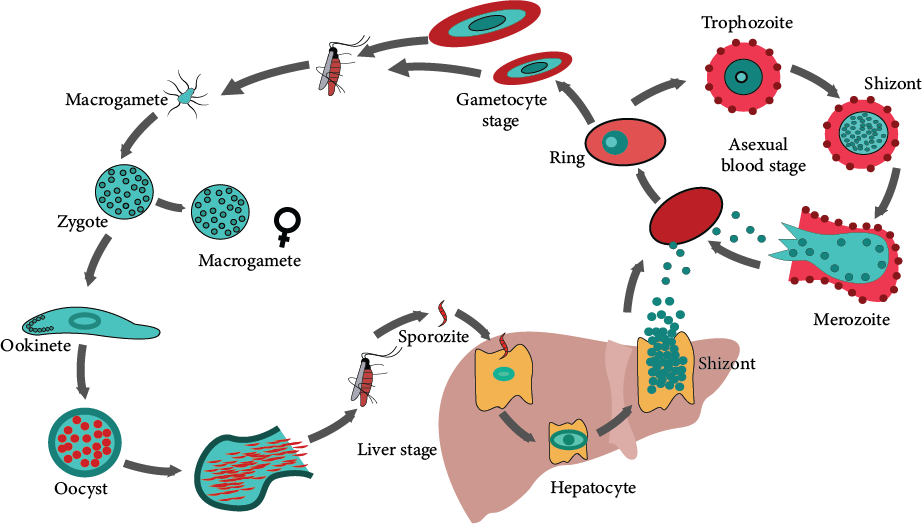
Life cycle of Plasmodium Falciparum
Types of Immunity
Immunity is defined as the ability of the body to protect and fight against any pathogen or foreign body.
The immune system defends our body against any infection.
There are Two Types of Immunity:
Innate immunity: This immunity is present at the time of birth. There are 4 types of barriers present in the defence mechanism of our body.
Physical Barriers: skin and mucous coating of the epithelial lining of the respiratory, gastrointestinal, and urinary tract.
Physiological Barriers: saliva, tears, and stomach acid.
Cellular Barriers: neutrophils, monocytes, natural killer lymphocytes.
Cytokine Barriers: interferons that are secreted by virus-infected cells.
Acquired Immunity: Acquired Immunity is something that we acquire during the lifespan moreover it is pathogen-specific in nature.
The primary response towards acquired immunity is seen after the first encounter with a pathogen.
Often infection results in secondary response or anamnestic response due to memory of the first response.
B-lymphocytes produce antibodies in response to a foreign antigen.
Antibodies are Y shaped protein molecules. Antibodies have 4 peptide chains out of these 2 are light and 2 are heavy in nature.
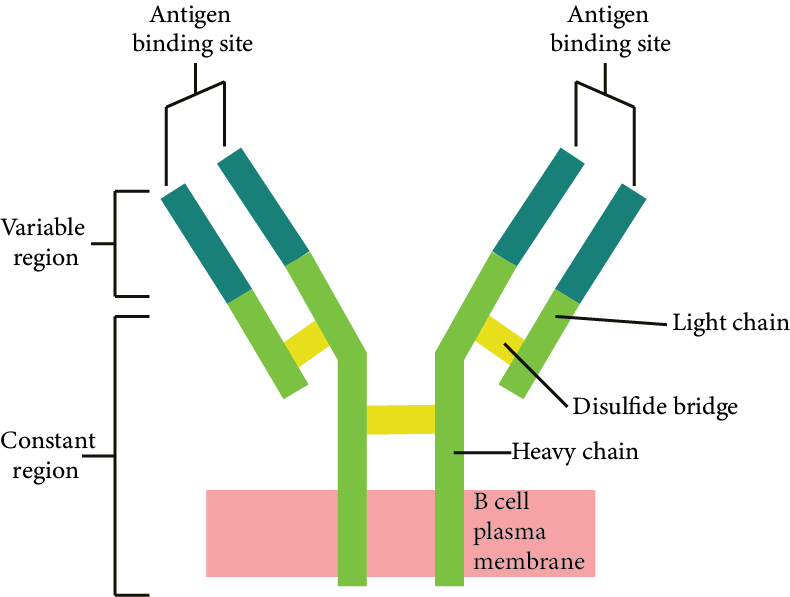
Structure of an Antibody
There are five types of antibodies present in humans; IgG, IgM, IgD, IgA and IgE.
IgG is the most abundant antibody that is found in the blood.
IgG is transferred to a foetus through the placenta and protects the infant until their own immunity develops.
IgA is present in the breast milk colostrum, the yellowish fluid secreted initially during lactation has a lot of IgA.
IgE is involved in the allergic reaction.
T-lymphocytes mediate the cell-mediated response.
Cell-mediated response is responsible for distinguishing between self and non-self.
Active Immunity: Antibodies are produced in the host body in response to antigen. Vaccination, where a pathogen is injected is a type of active immunity.
Passive Immunity: Giving ready-made antibodies to get the quick response against a pathogen is known as passive immunity. Injecting antitoxin for snakebite, which contains antibodies against the venom, is an example of passive immunity.
Recombinant DNA technology has helped in producing large-scale vaccine production.
The hepatitis-B vaccine is produced from yeast.
Allergies
Immune response to certain environmental antigens, e.g. pollens, dust, mites, etc.
IgE antibody is produced during an allergic reaction
Mast cell releases histamine and serotonin during an allergic reaction
Auto Immunity
When the body attacks self-cells it results in auto-immune disorder.
Rheumatoid arthritis is an auto-immune disorder
Immune System in The Body
The human immune system comprises lymphoid organs, cells and antibodies
Primary Lymphoid Organs: These include bone marrow and thymus. Here lymphocytes develop, get mature and are differentiated into antigen-specific lymphocytes.
Secondary Lymphoid Organs: These organs include spleen, lymph nodes, tonsils in the small intestine and appendix. These are the sites for reaction with antigen.
The spleen acts as a filter of the blood. It contains lymphocytes,phagocytes also erythrocytes are present.
Lymph nodes trap the antigens present in the lymph or tissue fluid.
Mucosa-associated Lymphoid Tissue (MALT): the mucosal lining of respiratory, urinary and digestive tract accounts for the 50% of total lymphoid tissues present in the body.
AIDS (Acquired Immunodeficiency Syndrome)
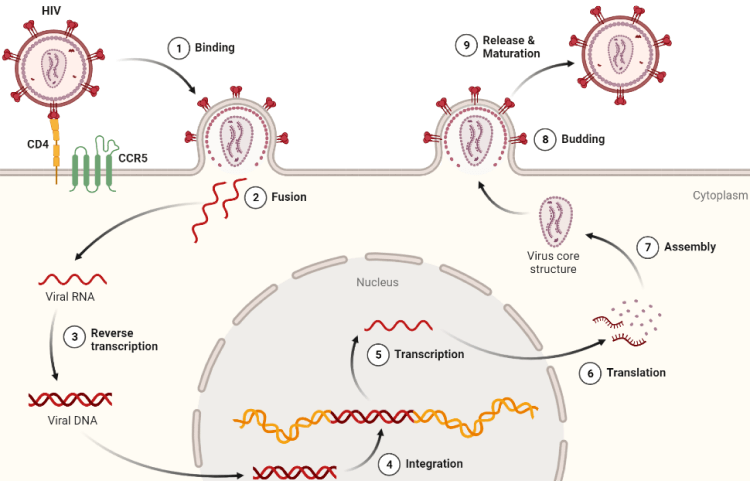
Life Cycle of HIV Virus
It is caused by HIV (Human Immunodeficiency Virus and It is a retrovirus with RNA as its genome.
The virus produces viral DNA in the host by the enzyme reverse transcriptase.
The viral DNA gets incorporated into the host genome and multiple copies of the virus are produced.
The virus attacks helper T-cells, where it replicates and multiplies, resulting in a marked decrease in the number of T lymphocytes.
The infected person shows weak immunity after the virus attacks T- helper cells.
AIDS patients become prone to various infections like mycobacterium, toxoplasma, fungal, and other viral infections.
ELISA (Enzyme-Linked Immuno-Sorbent Assay) is a widely used diagnostic test for AIDS.
AIDS may be transmitted by sexual intercourse, contaminated blood transfusion, using an infected syringe, or from mother to fetus through the placenta.
NACO (National AIDS Control Organisation) works for the awareness and prevention of AIDS by educating people and spreading awareness.
Cancer
Cancer is caused due to uncontrolled cell division leading to the formation of tumours.
There is a breakdown of regulatory mechanisms in the normal cells.
Cancerous cells lack contact inhibition property, which inhibits further growth of cells in contact with other cells.
Benign Tumors remain at their original location.
Malignant Tumors have invading ability and damage surrounding tissues. These are destructive in nature.
Metastasis: It is a property of a malignant tumor when cells sloughed off from it reach distant sites and form a tumor in the various parts of the body.
Cancer is caused due to DNA damage or genetic mutation resulting in the mismanaged regulation of the cell division.
Cancer can also happen due to the activation of proto-oncogenes present in normal cells.
Tumour suppressor genes, also known as anti-oncogenes, control the cell during cell division as well as replication, and if genes fail to function properly, these methods of cell division and replication become uncontrollable, potentially leading to cancer.
Carcinogens: ionising radiation, non-ionising radiation (UV rays), chemical agents (e.g. present in tobacco), viral oncogenes of oncogenic viruses.
Cancer can be diagnosed by using a CT scan (computed tomography), MRI (magnetic resonance imaging), X-ray, PET scan (positron emission tomography).
Cancer can also be diagnosed using molecular biology techniques to identify inherited genes which cause cancer.
Antibodies against cancer antigens can also be used for diagnostic purposes.
Cancer can be treated by surgery, transplantation and even radiation therapies are quite useful.
𝛂-interferon act as biological response modifier, which activates the immune system to destroy tumour and also is useful.
Drugs and Alcohol Abuse
Opioids, cannabinoids and coca alkaloids are commonly abused drugs.
Diacetylmorphine is commonly known as heroin or smack. It is extracted from the latex of the poppy plant Papaver somniferum.
Cannabinoids bind with the cannabinoid receptors present in the brain. They affect the cardiovascular system.
Cannabinoids, e.g. marijuana, hashish, charas, ganja, etc. are obtained from the flower tops, leaves.
Cocaine or coca alkaloid is obtained from the plant Erythroxylum coca.
Cocaine acts by interfering with the transport of dopamine, a neurotransmitter.
Atropa belladonna and Datura also have hallucinogenic properties.
Sportspersons also take cannabinoids to enhance their performance and can practice for long hours thus increasing stamina.
Morphine is used as a sedative and painkiller.
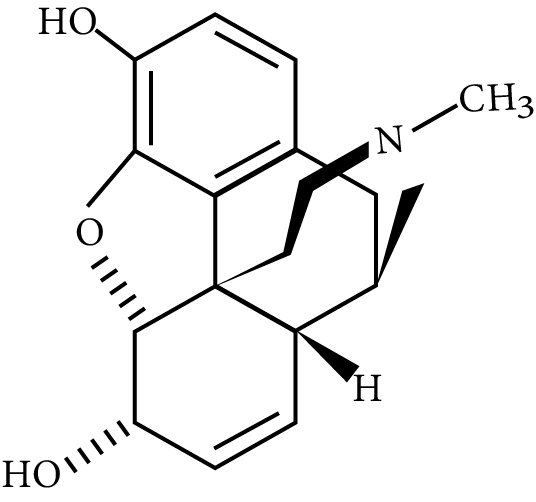
Morphine
Nicotine (alkaloid) present in tobacco releases adrenaline and nor-adrenalin hormone by the adrenal gland. It increases heart rate and blood pressure.
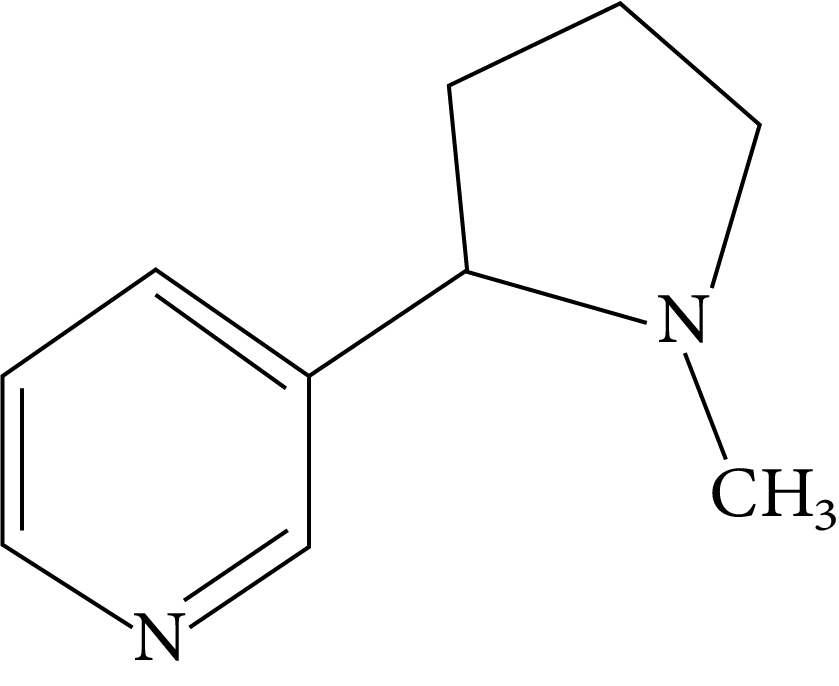
Nicotine
Smoking causes oxygen deficiency by increasing the concentration of carbon monoxide in the blood thereby decreasing the concentration of oxygen bound to haemoglobin.
The excessive use of drugs and alcohol damages the nervous system and causes liver cirrhosis so we should avoid them.
Anabolic steroids make men more masculine and make females more aggressive.
Key Points to Remember:
Health is more than simply the absence of disease. It is a perfect state of physical, mental, social, and psychological well-being.
Typhoid, pneumonia, cholera, fungal infections of the skin, malaria, and other diseases cause significant suffering in humans.
Malaria and other vector-borne diseases, particularly those caused by Plasmodium falciparum, can be fatal if not treated.
Aside from personal hygiene and cleanliness, public health initiatives such as proper waste disposal, disinfecting drinking water, vector control such as mosquito control, and immunisation are very effective in stopping these diseases.
When we are subjected to disease-causing agents, our immune system plays a critical role in avoiding these diseases.
Our bodies' innate defences, such as skin and mucous membranes, as well as antimicrobial substances found in tears and saliva, Phagocytic cells aid in the prevention of pathogen entry into our bodies.
If pathogens gain entry into our bodies, specific antibodies (humoral immune response) as well as cells (cell mediated immune response) kill them.
The cells of the immune system have memory. When exposed to the same pathogen again, the immune response is faster and more intense.
This is the foundation of the protection provided by vaccination and immunisation.
AIDS and cancer, among other diseases, affect a large number of people worldwide.
The human immunodeficiency virus (HIV) causes AIDS, which is fatal unless certain steps are taken.
Many cancers are treatable if detected early and appropriate treatment is administered.
Drug and alcohol misuse among youth and adolescents has recently increased. Because of the addictive qualities of alcohol and drugs, as well as their perceived benefits such as stress relief, a person may experiment with them in the face of peer pressure, exam-related, and competition-related stresses. As a result, he or she may become addicted to them.
Individuals would be completely liberated from these evils if they were educated about their harmful effects, counselled, and sought immediate professional as well as medical help.
Importance of Human Health and Disease in NEET
As we have discussed earlier, the chapter introduces different concepts of human health and diseases. For NEET students, this chapter is a crucial addition to the syllabus as they can learn about different ailments that humans can have. The chapter covers major diseases that are caused by bacteria, viruses, protozoa, fungi, and much more. Different modes of treatment for some of the diseases are also discussed in the chapter with proper definitions.
The fundamental concepts of the chapter can be further discussed in Human Health and Disease NEET notes. Students can learn about the immune system in human beings and familiarize themselves with the concept of immunity, innate immunity, acquired immunity, and autoimmunity. The topics of vaccines and allergies are also discussed in the chapter for the easy understanding of students.
Also, the chapter talks about deadly diseases in human beings such as AIDS (HIV), Cancer, Tumors, and much more. It also explains how these diseases are caused and what is done to prevent or treat such diseases. These explanations will provide the much-needed explanation to students for their preparation for NEET. The students will also learn about drug and alcohol abuse, what problems it might cause, prevention methods etc.
The core concepts that have been covered in this particular chapter can be properly understood using the explanations and easy-to-access information provided in the Human Health and Disease NEET notes PDF files. Learn all about the important diseases that can be caused to the environment that we live in. Students can learn the cause of the diseases, the treatment methods, as well as the prevention tactics. Such details can be crucial for NEET preparation and hence one needs to download these notes right now.
Benefits of Vedantu’s Human Health and Disease NEET Notes
The PDF files are easy to download and free of cost. These notes can be accessed from any working mobile device.
The revision notes are formulated by experienced subject matter experts at Vedantu so that students can be offered a convenient study source on the chapter for their NEET preparation.
Our subject matter experts have left no detail unexplained in the revision notes so that students don’t have any difficulty comprehending the explanations and discussions about the topics. This also helps in building a strong foundation for the chapter.
The revision notes contain important questions and answers along with worksheets that can help students practice from a very crucially accumulated list of questions for their NEET examination.
Download Human Health and Disease NEET Free PDF
If you want to prepare for your NEET examination, make sure to go for Human Health and Disease Class 12 notes PDF download for sure. The simplest descriptions and easy-to-understand language will be a definite help.
Other Important Links
Other Important Links for NEET Human Health and Disease |
NEET Biology Revision Notes - Chapter Pages
NEET Biology Chapter-wise Revision Notes | |
Human Health and Disease Notes | |
FAQs on Human Health and Disease NEET Notes 2024 - Free PDF Download
1. What are the different Tumor types?
According to Human Health and Disease Class 12 notes, there are 3 types of tumours namely, Benign, Pre-Malignant, and Malignant.
2. Can a Benign tumour be cancerous?
No, a Benign tumour cannot be cancerous since they aren’t able to mutate and spread all over the body.
3. What is immunity?
The ability of one’s body to fight against threatening factors that could potentially harm the well-being of the individual is known as immunity. Either immunity can be inborn or acquired.
4. Mention the different components of the immune system?
The major components of the human immune system include white blood cells, antibodies, bone marrow, lymphatic system, spleen, and thymus.






